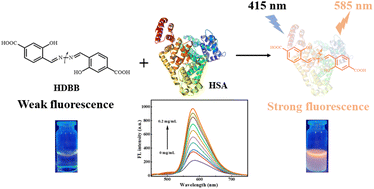An HDBB-based fluorescent probe for the sensitive detection of human serum albumin†
Abstract
The detection of human serum albumin (HSA) in bodily fluids is of great significance in the biomedical area because HSA in bodily fluids is commonly used as a biomarker for the early diagnosis of diseases. To detect HSA, we employed HDBB, 4,4′-(hydrazine-1,2-diylidene bis(methanylylidene)) bis(3-hydroxybenzoic acid), as a fluorescent probe with a large Stokes shift. HDBB had obvious excited state intramolecular proton transfer (ESIPT) and aggregation-induced emission (AIE) features. We elucidated the ESIPT characteristics of HDBB through the DFT approach. We also performed a molecular docking simulation between HDBB and HSA, showing that HDBB primarily bonded to HSA via hydrophobic force and hydrogen bonds. The FL intensities of HDBB with HSA concentrations had a linear range of 0.01–0.2 mg mL−1 (R2 = 0.9995), and the LOD was 1.104 μg mL−1. We also used the probe to detect HSA in urine, with spiked recoveries of 98.10–105.33%. Given its high selectivity and feasible synthesis, HDBB has potential applications in detecting HSA in real biological systems.



 Please wait while we load your content...
Please wait while we load your content...